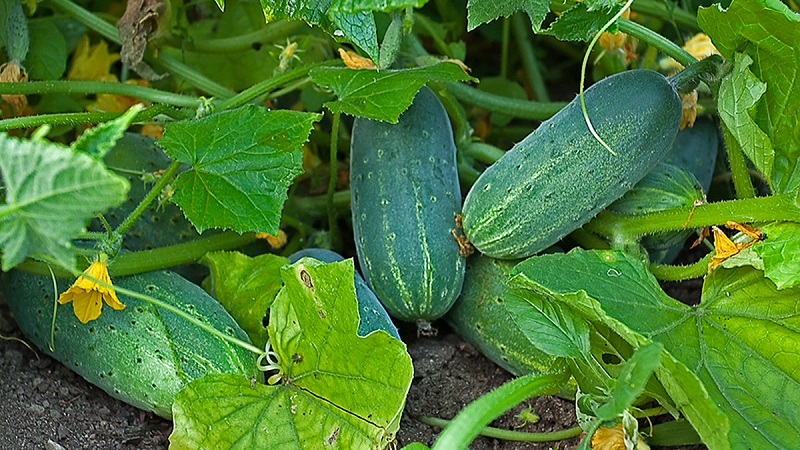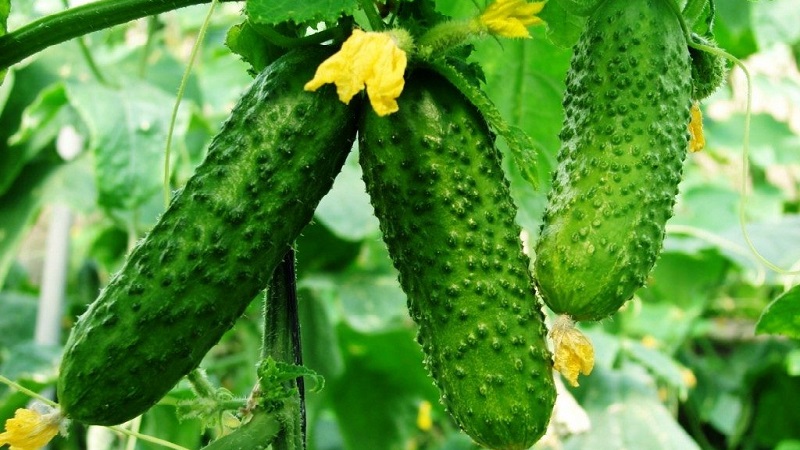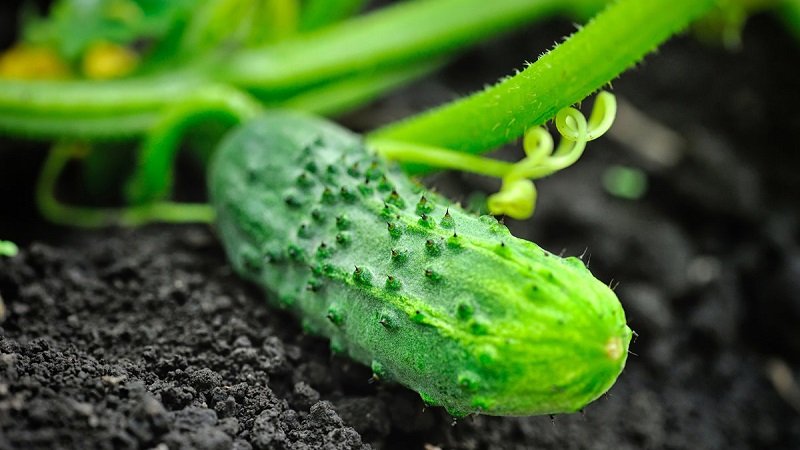Extending the fruiting period of cucumbers: effective recipes for feeding in August
Many people associate cucumbers with spring and early summer. Previously, only garden radishes appear on the tables. At the same time, many gardeners notice that in the middle of summer the yield decreases, and in mid-August the culture ceases to bear fruit altogether.
Meanwhile, the fruiting of cucumbers is possible even in September. This plant is capable of producing crops before the first frost, not only in the greenhouse, but also in the open field. To achieve this effect, summer residents use several tricks. And the main role in the prolongation of fruiting is played by top dressing.
The content of the article
Why are cucumbers fed during the flowering and fruiting period
The root system of cucumbers is poorly developed. It absorbs nutrients from the surface layer of the earth. The culture is demanding on the composition of the soil. In poor soils, it stops bearing fruit or produces tasteless little cucumbers.
Cucumbers are fed more often than other crops... Three dressings per season are enough for tomatoes and eggplants, and cucumber beds are fertilized up to five times.

Fertilizers are applied even during flowering and fruiting.... In order not to get a crop saturated with harmful substances, it is important to use safe products that do not contain components hazardous to health.
Late dressings serve several functions.:
- Increased yield and prolongation of fruiting. By August, the reserves of nutrients in the soil are depleted, and cucumbers are capable of producing rich harvests only in fertile soil. Late feeding will help normalize the balance.
- Increasing resistance to negative factors environment. This property is especially valuable in late August and September.
- Boosting immunity... It is at the end of summer that epidemics of most diseases begin, which is associated with increased humidity and temperature extremes. With a lack of nutrients, plants are more susceptible to infections. In rich soil, the risk that cucumbers will be attacked by fungi and viruses is significantly reduced.
- Correct fruit formation... In poor soil, cucumbers will turn out to be uneven, lethargic and ugly.
Top dressing rules
When applying fertilizers, a number of basic rules are observed, otherwise the procedure will bring harm to the plantings, and not benefit:
- The day before top dressing under the root, cucumber beds are watered abundantly. This minimizes the risk of root burns.
- Important observe the recommended dosages... Failure to comply with this rule is fraught with burns on the roots of plants and an increase in green mass, crushing of fruits.
- Dry (granular) fertilizers will give the maximum result at a depth of 10 cm. They are deepened in two ways. The first option is to scatter the granules on the ground and loosen the beds. The second (more correct) method is to carefully remove the top layer of soil, sprinkle the fertilizers, then cover them with an even layer of soil.
- Liquid preparations are poured so that they did not hit the leaves and stems. In dry weather, even with pre-irrigation, nutrient formulations are poured into grooves dug between plantings. In wet weather, fertilizer is poured directly under the root.
- After top dressing the ground part of the bush is sprayed with water. This is necessary to wash off drops of the drug that have fallen on the ground part of the bush.
- Top dressing is applied when the sun is inactive... It is desirable that the weather be warm on this day.Then the procedure will be as effective as possible and will not harm the culture.
Fertilizers and recipes
Top dressing for cucumbers to increase fruiting is applied in August and September... At the same time, it is important to choose the most harmless compositions - then the harvested crop will not only be plentiful, but also safe.
There are several types of fertilizers... Some of them are easy to make yourself, others will have to be purchased.

Organic
Organic fertilizers contain a lot of nitrogen. They will prevent the plant from withering and strengthen the immune system. There are also mineral components in such compositions, they contribute to the development of fruits and the formation of ovaries.
Attention! Organic compounds are applied only at the root. They should not fall on the leaves. It is important not to apply such fertilizers excessively, otherwise a lot of greenery will form on the bush, and the fruits will become small.
What kind organic compounds help to prolong the fruiting period:
- Bird droppings... For 9 liters of water, 1 kg of manure is taken. The mixture is infused for three days. 1 liter of the composition is poured under each plant. To increase effectiveness of the remedy, add 1 glass of ash to it.
- Cow dung... Take 0.5 kg of funds for a bucket of water. He is allowed to brew for three days, after which 0.5 liters are poured under each plant.
- Horse dung... For 10 liters of water, take 2 kg of manure and 1 kg of withered foliage or sawdust. The mixture is allowed to brew for two weeks. After that, each plant is fed with 0.5 liters of fertilizer.
- Ash... it remedy will help not only to lengthen the fruiting period, but also to improve the quality of fruits due to the presence of potassium and phosphorus in the composition. To prepare the product, the bucket is 1/3 filled with ash, the rest of the volume is poured with warm water. The mixture is insisted for three days, stirring occasionally. Then it is filtered and used for watering. Under each bush, add 0.5 kg of funds.
- Banana peel... Three banana peels are poured over 3 liters of warm water. The mixture is infused for a week, after which the peel is removed, and the infusion is diluted with water in a 1: 1 ratio. 1 liter of fertilizer is poured under each bush.
- Herbal infusion... Weeds (preferably nettles) are cut and placed in a bucket. The grass should be half full. The rest of the volume is topped up with water. The mixture is covered with a lid and insisted for a week. Then it is filtered and diluted with water. For 10 liters of water, take 2 liters of herbal infusion. 1 liter of fertilizer is poured under each bush.
- Eggshell... The shell of 10 eggs is crushed and filled with 2 liters of water. The mixture is infused for 10 days. The resulting composition is diluted with 8 liters of water.
- Yeast... Add 2 tbsp to a three-liter jar. l. yeast and 2 tbsp. l. Sahara. Sugar with yeast pour water and let it brew for 24 hours. The resulting infusion is diluted with 7 liters of water. Use 1 liter of the product per plant.
- Vegetable peelings... The skins of onions, potatoes, eggplants are put in a bucket. The cleanings should be 1/3 full. The rest of the volume is topped up with water. The mixture is infused in a warm place for five days. Then add 2 liters of infusion to a bucket of water.
Manure for the preparation of fertilizers must be rotted... To enhance the effect of diluted manure, ash is added to it. In this case, a complex fertilizer containing nitrogen, potassium and phosphorus is obtained.
Mineral
To increase the duration of fruiting, use mineral fertilizers... They are responsible for the quality and quantity of fruits.

In late summer and autumn, the following formulations are used:
- Potassium nitrate. Means accelerates the formation of ovaries, enhances cellular respiration, activates immunity, improves the taste of fruits. For 10 liters of water, take 25 g of the drug. For 1 bush, 1 liter of fertilizer is consumed.
- Urea. Means refers to nitrogen fertilizers, promotes the tying of new lashes. Acts as a pest control agent. In a ten-liter bucket of water, dilute 50 g of the drug. 1 liter of fertilizer is used per plant.
- Magnesium sulfate... Strengthens the immune system, improves the taste of fruits, increases resistance to negative environmental factors. To prepare the product, add 10 g of mania to a bucket of water. For one cucumber bush, no more than 0.5 liters of funds are spent.
- Superphosphate... Strengthens the root system, activates the immune system. For 10 liters of water, take 30 g of the product. One bush uses 1 liter of the composition.
Complex fertilizers are often used... In this case, several drugs are dissolved in water at once.
Important! Mineral dressing is applied not only at the root. They are also used as foliar fertilizers.
Biostimulants
Biostimulants are considered the safest purchased funds... They are allowed and even recommended to feed cucumbers in August - they prolong and even resume the vegetation of plants.
What biostimulants are used for feeding cucumbers:
- "Etamon"... Improves root development, increases the absorption of other nutrients. To prepare fertilizer, 1 g of the drug is diluted in a bucket of water. The resulting solution is sprayed with plants or fertilized at the root. Use 200 ml of the product for each bush.
- "Gumi-20"... It contains all the substances necessary for the plant. Accelerates the formation of ovaries, improves the taste of fruits, increases immunity and resistance to adverse environmental factors. To prepare the product, 300 ml of the product is diluted in 10 liters of water.
- "Silk"... Improves the quality of the crop and accelerates its ripening, helps plants better cope with stress factors. This drug is used for spraying plantings. To prepare a solution in 2.5 liters of water, dilute 0.5 sachets of the product. The received amount of funds is enough to process 7.5 m².
- "Azotovit"... Increases productivity, output of fruits, allows you to get an environmentally friendly harvest, activates the development of the root system. The drug is used during the active flowering period. To prepare the solution, add 10 liters of the drug to a bucket of water. Fertilizer is applied at the root.
- Ferovit... Improves photosynthesis, increases resistance to negative environmental factors. To prepare a solution for 10 liters of water, take 7.5 ml of the drug.
Folk recipes
Folk remedies will help to preserve plants in case of small frosts and to extend their fruiting period.

The list contains several effective formulations:
- Soda... A product that helps with nitrogen deficiency and increases the resistance of plants to weather changes. Add 1 tbsp to a bucket of water. l. baking soda... The resulting solution is sprayed with cucumber plantings.
- Iodine... Add to the bucket of water 20 drops of iodine and 2 liters of milk, whey or kefir. The agent is applied at the root or used for spraying plants.
- Boric acid... Accelerates the formation of ovaries. The tool is effective as a foliar dressing and when applied at the root. To prepare the product, 1 g of the drug is added to a bucket of water.
- Ammonia... Helps with nitrogen deficiency (yellowing of leaves, loss of turgor). Add 5 ml of ammonia to a bucket of water.
- Aspirin... Only suitable for alkaline soil. For 10 liters of water, take 10 crushed aspirin tablets. Pour 1 liter of the product under each bush.
Such funds are used as root and foliar feeding.... At the same time, it is important to observe the concentration of drugs, especially pharmaceuticals.
Advice! Test a new product on one plant before using it on all plantings. If nothing happens to the bush in a day, use the drug on the rest of the bushes.
Basic recommendations and tips for prolonging the fruiting of cucumbers
The fruiting period of cucumbers depends not only on top dressing... Compliance with a number of rules and knowledge of the nuances will help achieve the desired result.
How to prolong the fruiting of cucumbers in the open field in August:
- Mulching... This is one of the most important rules.Covering the beds with a layer of rotted straw, hay or compost will protect the plant roots from frost. In addition, mulch protects plants from pests and provides additional nutrition for cucumbers.
- Seat selection... The area where cucumbers grow should be protected from the wind from all directions, but at the same time sunny. Compliance with crop rotation is equally important. If melons and gourds grew on this place before the cucumbers, the soil will be depleted.
- Protection... In August, the weather is unstable. Therefore, during noticeable cold snaps, cucumbers are covered with a film. For this, a frame is constructed of wood or metal rings.
- Watering... In the second half of August, the nights get cold. At this time, plantings are watered only in the morning.
- Planting method... Vertical beds provide plants with optimal air exchange. This ensures long-term fruiting.
- Sowing... It is recommended to sow cucumber seeds at different times, thereby prolonging their fruiting times. Another way to get cucumber fruits all summer is to plant varieties with different ripening periods.
- Attracting pollinators... To do this, plants blooming in August or September are planted next to the cucumber beds, or cucumbers are sprayed with sweet water.
- Timely harvest... The sooner some cucumbers are harvested from the bush, the faster others will appear. The plant gives all its strength to the already formed fruits, which does not allow new ones to form.
Conclusion
Cucumbers are able to bear fruit before the first frost, but they usually wilt and cease to yield much earlier. This is due to non-observance of the rules of care and soil depletion.
To get a large number of tasty, ripe fruits until mid-autumn, experienced gardeners use effective feeding, follow the basic rules of care and use some tricks.